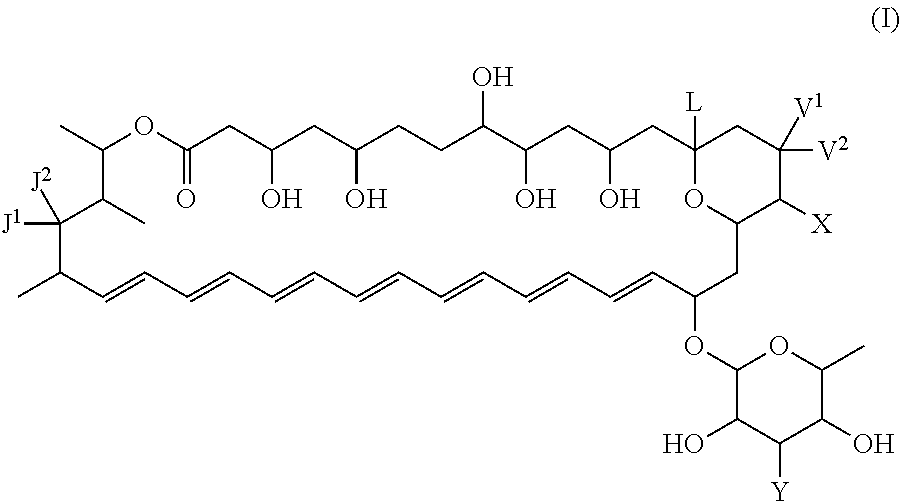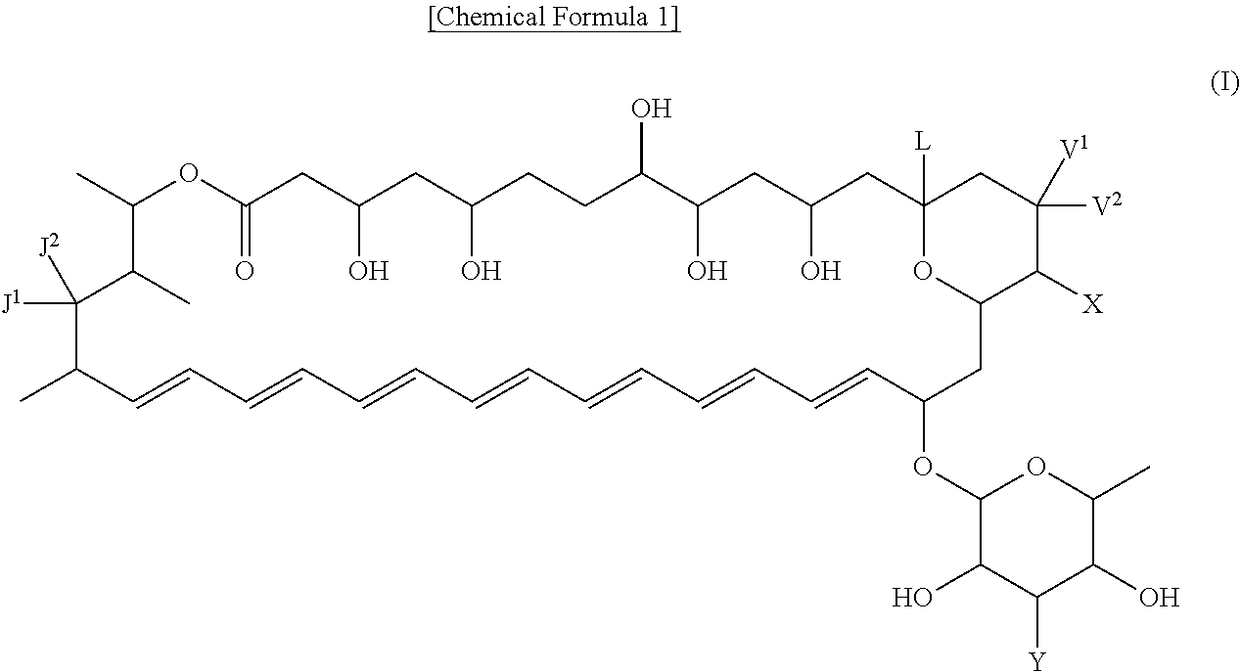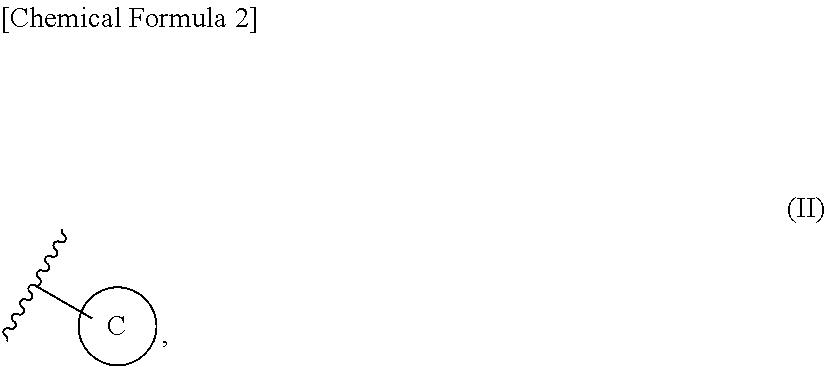Polyene macrolide derivative
- Summary
- Abstract
- Description
- Claims
- Application Information
AI Technical Summary
Benefits of technology
Problems solved by technology
Method used
Image
Examples
reference example 1
nd III-a
[0416]
Step 1 Synthesis of Compound I-a
[0417]Amphotericin B (5 g, 5.41 mmol) was dissolved in DMF (25 mL) and added triethylamine (10 mL, 72.1 mmol) and N-[2-(trimethylsilyl)-ethoxycarbonyloxy]succinimide (3.51 g, 13.5 mmol), and the mixture was stirred for an hour at room temperature. Diisopropyl ether and acetonitrile were added, and the resulting solids were filtered. Compound I-a (7.11 g) was obtained as crude by evaporating in vacuo.
[0418][M+Na]+=1090
Step 2 Synthesis of Compound II-a
[0419]Compound I-a (2 g, 1.87 mmol) was dissolved in methanol (20 mL), and stirred for 10 minutes in an ice-water bath. Camphorsulfonic acid (0.609 g, 2.62 mmol) was added and stirred for an hour in an ice-water bath. Methanol was removed by evaporating in vacuo, and the residue was resolved in a little methanol. The obtained methanol solution was added dropwise to diisopropyl ether (500 mL) to give Compound II-a (1.8 g, 89%).
Step 3 Synthesis of Compound III-a
[0420]Compound II-a (1.8 g, 1.66 ...
reference example 2
nd III-b
[0422]
Step 1 Synthesis of Compound I-b
[0423]Amphotericin B (10.07 g, 10.9 mmol) was dissolved into N-methylpyrrolidone (50 mL) and methanol (50 mL) and added N,N-diisopropylethylamine (5.7 mL, 32.7 mmol) and Alloc-OSu (2.6 g, 13.1 mmol), and the mixture was stirred for 2 hours 30 minutes at room temperature. The reaction mixture was added to diisopropyl ether / methanol (10 / 1, 550 mL) and stirred strongly. The deposited powder was filtrated. The obtained solids was washed with isopropylether and evaporated in vacuo to give Compound I-b (11.58 g) as crude. The retention time of Compound I-b was 10.4 minutes by HPLC analysis (methanol / distilled water containing 0.1% PIC-B7=gradient from 70 / 30 to 100 / 0, flow speed 1 ml / min, wavelength of detection=385 nm). The retention time of raw material amphotericin B was 8.6 minutes under the same condition.
[0424][M+Na]+=1032.5
Step 2 Synthesis of Compound II-b
[0425]Compound I-b (9.8 g, 7.78 mmol) was dissolved into tetrahydrofuran (150 mL) a...
reference example 3-1
I-A and Compound II-A
[0428]
Step 1 Synthesis of Compound I-A
[0429]Amphotericin B (5 g, 5.41 mmol) was dissolved in DMF (50 mL), followed by the addition of DIEA (10 mL, 27.1 mmol). Allyloxycarbonyl chloride (3.51 g, 13.5 mmol) was added dropwise at 4° C. or below under control, and the mixture was stirred for 2 hours 50 minutes in an ice-water bath. After heating to room temperature, the mixture was stirred for 4 hours. The mixture was added dropwise to the solvent mixture of diisopropyl ether / methanol (4 / 1, 500 mL). After the mixture was incubated at room temperature, the obtained solids were filtrated to give Compound I-A (5.85 g). The retention time was 12.4 minutes by HPLC analysis (methanol / distilled water containing 0.1% PIC-B7=gradient from 70 / 30 to 100 / 0, flow speed 1 ml / min, wavelength of detection=385 nm).
[0430][M+H]=1093.9
Step 2 Synthesis of Compound II-A
[0431]Compound I-A (5.28 g, 4.83 mmol) was dissolved into DMA (25 mL), followed by the addition of DIEA (1.26 mL, 7.25 m...
PUM
| Property | Measurement | Unit |
|---|---|---|
| Length | aaaaa | aaaaa |
Abstract
Description
Claims
Application Information
 Login to View More
Login to View More - R&D
- Intellectual Property
- Life Sciences
- Materials
- Tech Scout
- Unparalleled Data Quality
- Higher Quality Content
- 60% Fewer Hallucinations
Browse by: Latest US Patents, China's latest patents, Technical Efficacy Thesaurus, Application Domain, Technology Topic, Popular Technical Reports.
© 2025 PatSnap. All rights reserved.Legal|Privacy policy|Modern Slavery Act Transparency Statement|Sitemap|About US| Contact US: help@patsnap.com



